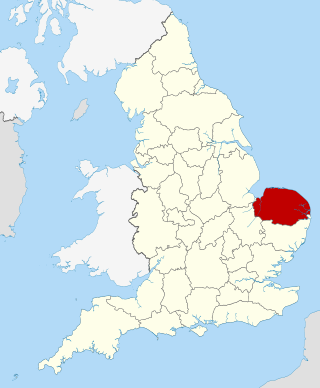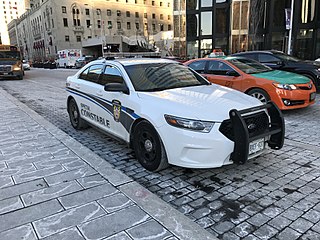A constable is a person holding a particular office, most commonly in law enforcement. The office of constable can vary significantly in different jurisdictions. Constable is commonly the rank of an officer within a police service. Other people may be granted powers of a constable without holding this title.

A tipstaff is an officer of a court or, in some countries, a law clerk to a judge. The duties of the position vary from country to country. It is also the name of a symbolic rod, which represents the authority of the tipstaff or other officials such as senior police officers.
Proctor is a person who takes charge of, or acts for, another.

Cambridgeshire Constabulary is the local territorial police force that covers the county of Cambridgeshire and Peterborough unitary authority. It provides law enforcement and security for an area of 1,311 square miles (3,400 km2) and population of 856,000 people, in a predominantly rural county. The force of Cambridgeshire includes the cities of Cambridge, Ely and Peterborough, the market towns of Chatteris, Huntingdon, March, Ramsey, St Ives, St Neots, Whittlesey, and town and Port of Wisbech. Its emblem is a crowned Brunswick star containing the heraldic badge of Cambridgeshire County Council.

Norfolk Constabulary is the territorial police force responsible for policing Norfolk in East Anglia, England. The force serves a population of 908,000 in a mostly rural area of 2,079 square miles (5,380 km2), including 90 miles (140 km) of coastline and 16 rivers, including the Broads National Park. Headquartered in Wymondham, Norfolk is responsible for the City of Norwich, along with King's Lynn, Great Yarmouth and Thetford. As of March 2023, the force has a strength of 1,897 police officers, 163 special constables, 1,318 police staff/designated officers, and 103 police support volunteers. The Chief Constable is Paul Sanford, and the Police and Crime Commissioner (PCC) is Sarah Taylor (Labour).

The City of Glasgow Police or Glasgow City Police was the police covering the city and royal burgh of Glasgow, from 1800 to 1893, and the county of city of Glasgow, from 1893 to 1975. In the 17th century, Scottish cities used to hire watchmen to guard the streets at night, augmenting a force of unpaid citizen constables. On 30 June 1800 the authorities of Glasgow successfully petitioned the British Government to pass the Glasgow Police Act 1800 establishing the City of Glasgow Police. It served Glasgow from 1800 to 1975, when it was amalgamated into Strathclyde Police.

The Metropolitan Police District (MPD) is the police area which is policed by the Metropolitan Police Service in London. It currently consists of the ceremonial county of Greater London, which excludes the City of London. The Metropolitan Police District was created by the Metropolitan Police Act 1829 as an ad hoc area of administration because the built-up area of London spread at the time into many parishes and counties without an established boundary. The district expanded as the built up area grew and stretched some distance into rural land. When county police forces were set up in England, those of Essex, Hertfordshire, Kent and Surrey did not cover the parts of the counties within the MPD, while Middlesex did not have a county force. Similarly, boroughs in the MPD that elsewhere would have been entitled to their own police force did not have them.
Newham Community Constabulary, formerly called Newham Parks Constabulary, was a very small non-Home Office constabulary responsible for patrolling the 52 parks and open spaces covering 1.63 square miles in the London Borough of Newham.
The Kew Constabulary is a small, specialised constabulary responsible for policing the Royal Botanic Gardens at Kew in Richmond-upon-Thames, England.

The Oxford University Police, or Oxford University Constables, was the private police force of the University of Oxford between 1829 and 2003. They carried warrant cards and were empowered to act as police officers within the university precincts and within areas of Oxford within four miles of any university building. As of 2001, the force existed as a private constabulary with 40 sworn constables. They were widely recognised for the bowler hats which formed part of their uniform, and formerly had the duty of patrolling outside the Examination Schools alongside the university proctors, the officials responsible for discipline in the university. They were abolished by the University Council in 2003.

The Admiralty Constabulary was a police force in the United Kingdom formed under the Special Constables Act 1923. It was formed on 1 October 1949 by merging the Royal Marine Police and the Royal Marine Police Special Reserve and the Admiralty Civil Police. That Admiralty Constabulary was in turn amalgamated with the Army Department Constabulary and the Air Force Department Constabulary in 1971 to form the Ministry of Defence Police.
In the U.S. state of Texas, a constable is an elected law enforcement officer for a precinct of a county. Counties may have between one and eight precincts each depending on their population.

The history of law enforcement in the United Kingdom charts the development of law enforcement in the United Kingdom and its predecessor states. It spans the period from the Middle Ages, through to the development of the first modern police force in the world in the nineteenth century, and the subsequent modernisation of policing in the twentieth and twenty-first centuries.

A special constable or special police constable can refer to an auxiliary or part-time law enforcement officer or a person who is granted certain (special) police powers.

The Universities Act 1825 is an Act of the Parliament of the United Kingdom which provides for officers of police constable status within Cambridge and Oxford universities. Sections 3 and 4 have been repealed. In 2003, the University of Oxford closed its police force to avoid the complexity and costs of complying with new standards.
The Liberty of Peterborough Constabulary was the territorial police force responsible for law enforcement surrounding 'The Soke of Peterborough', England, from 1856 to 1947. It was initially controlled by the Chief Constable of Northamptonshire Captain Henry Lambert Bayly 1857 - 1876. The constabulary had its headquarters in the old gaol behind the Sessions House on Thorpe Road in Peterborough.
In the United States, there is no consistent use of the office of constable throughout the states; use may vary within a state. A constable may be an official responsible for service of process: such as summonses and subpoenas for people to appear in court in criminal and/or civil matters. They can also be fully empowered law enforcement officers. Constables may have additional specialized duties unique to the office. In some states the constable is an elected or appointed position at the state or local level of local government. Their jurisdiction can vary from statewide to county/parish and local township boundaries based on the state's laws.

The High Constables of Edinburgh are a prestigious body of constables, founded in 1611 and located in Edinburgh, Scotland. Historically, the High Constables were charged with policing the streets of Edinburgh, the capital city of Scotland, however today their duties are mostly ceremonial. It is believed that the High Constables of Edinburgh are the first example of a statutory police force in the world. At one time they formed part of the now defunct Corporation of the City of Edinburgh and continue to serve a ceremonial function in the local government of Edinburgh.

The Hampstead Heath Constabulary (HHC) is the organisation that patrols Hampstead Heath, London, which is administered by the City of London Corporation.












